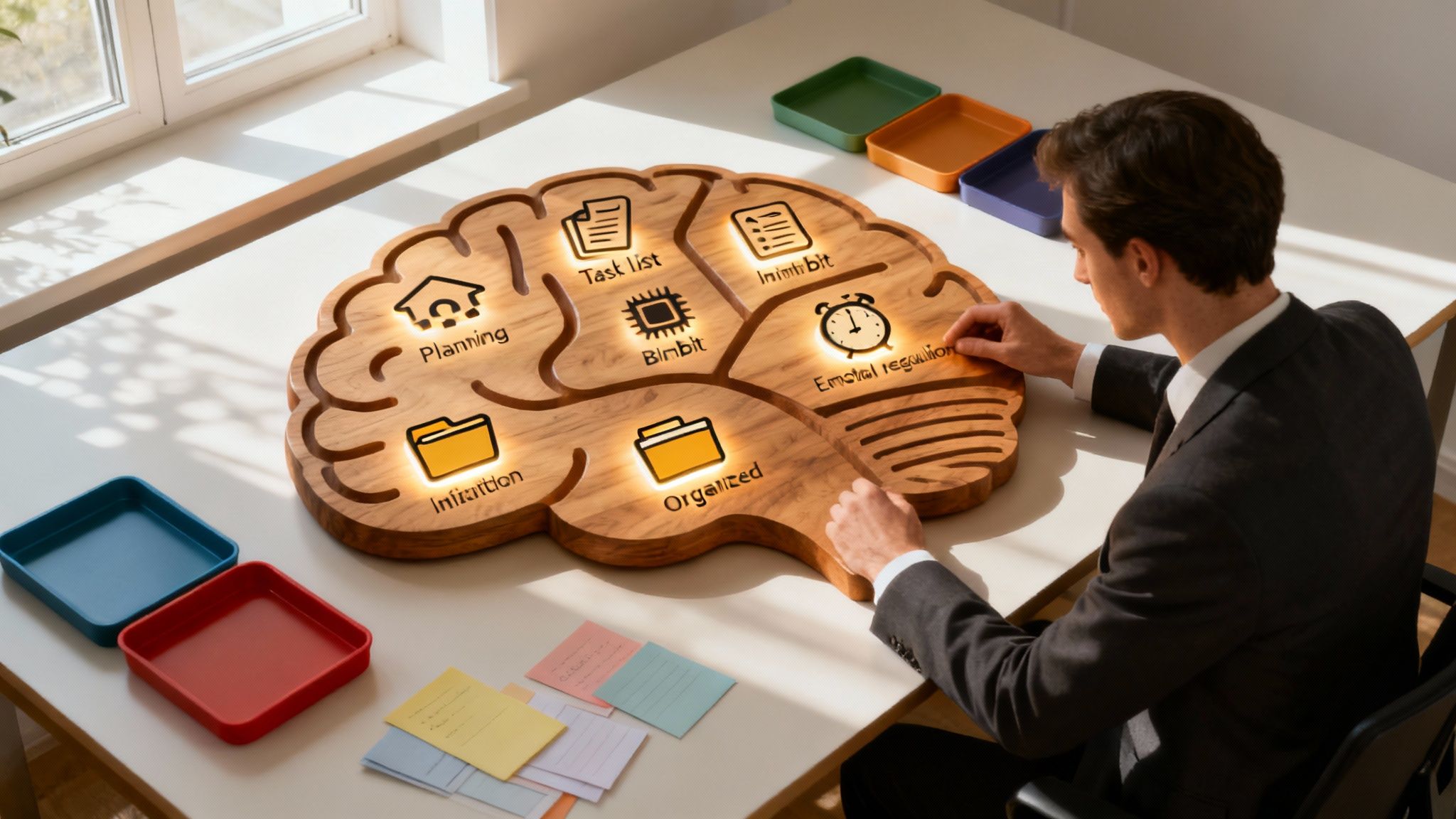Over 366 million adults are affected by attention-deficit/hyperactivity disorder (ADHD) globally.1 This neurodevelopmental disorder includes symptoms like: being easily distracted, impulsive behavior, struggling with time management and estimating time (AKA “time blindness”), and frequent forgetfulness—to name a few.
But one of the most overlooked symptoms of ADHD is emotional dysregulation - a symptom that makes it difficult to rein in intense emotions. While there’s nothing inherently wrong with “feeling our feelings,” the balancing act of processing and regulating emotions doesn’t come easy for most ADHDers.
Too long; didn’t read
Emotional dysregulation can happen to anybody, but people with ADHD are especially susceptible to it due to differences in our neuroanatomy and brain chemistry. With the help of a few mindfulness techniques and learning to recognize your triggers, you can better cope with intense emotions that arise.
What is emotional dysregulation?
Emotional dysregulation is the inability to moderate emotions and often causes extreme emotional reactions, fluctuating moods, and difficulty calming down.2
Common signs of emotional dysregulation
- Easily crying over situations (real or fictional) that may not affect others
- Angry outbursts
- Difficulty calming down
- Low tolerance for stress and frustration
- Sudden mood swings
- Easily overwhelmed
How is ADHD connected to emotional dysregulation?
ADHD is a neurodevelopmental disorder that has negative effects on executive functioning skills, which affects our ability to stay on task, gauge time, and self-regulate. While emotional dysregulation isn’t an official diagnostic criteria in the DSM 5, studies show that 70% of adults with ADHD struggle with managing their emotions.3
Processing emotions
Emotions that adults and children with ADHD commonly struggle to regulate include:
- Elation
- Anger
- Fear
- Grief
- Frustration
Tied to these emotions is rejection sensitive dysphoria (RSD), which is the pervasive sense of social anxiety, shame, and rejection—or just the fear and anticipation of these emotions.
What causes emotional dysregulation?
The main thing that contributes to the dysregulation of emotional responses? Your brain.
Let’s take a look at the different brain regions (neuroanatomy) that can affect you ability to regulate emotions.
.png)
The prefrontal cortex
The prefrontal cortex contributes to executive functioning control, which includes the regulation of emotional responses. Contextually, this region of the brain helps you regain composure or speak calmly in tense situations.
A 2011 study found that people are more likely to submit to their automatic emotional responses when the prefrontal cortex is compromised4—and additional research shown that the area that regulates dopamine production within the prefrontal cortex is much smaller in those with ADHD.5
This explains why people with ADHD often react out of impulse and have difficulty controlling their emotions.
The amygdala
The amygdala is small structure located near the center of the brain (mid-brain) with the chief responsibility of processing stimuli and responding with (its perception of) the appropriate emotional response.6
It's mostly known for its involvement with the fight or flight response.
Scientists have discovered that smaller amygdalas contribute to the development of major depressive disorder (MDD)7, indicating that the size of this brain structure may be correlated with a deficit in regulating intense emotions.
Mental health conditions
Certain disorders can also contribute to emotional dysregulation, including:
- ADHD
- Generalized anxiety disorder (GAD)
- Depression
- Bipolar disorders
- Eating disorders
- Substance use disorders (SUD)
- Autism
- Borderline personality disorder (BPD)
- Obsessive-compulsive disorder (OCD)
- Post-traumatic stress disorder (PTSD)
How to cope: strategies and tips
1. R.A.I.N. method
The R.A.I.N. Method is a form of mindful meditation, which stands for:
R - Recognize
Name your emotions without judgment.
A - Allow
Just let the emotions simply exist.
I - Investigate
Probe the reason behind these emotions and what may have caused it.
N - Nurture
Separate yourself from the emotions; they do not define you.
2. F.O.U.L. method
Dr. George Sachs, a clinical psychologist specializing in ADHD and a co-founder of Inflow, recommends trying the F.O.U.L. method when you feel a flood of anger. This method helps you recognize when intense feelings arise, and uncovers what may be causing them.
Here’s how it works:
F - Fact check
Gather the facts - what actually happened?
OU - Opposite Urge
If and when you feel the urge of physical anger (i.e. yelling, punching things), pause and ask yourself what the opposite urge would be - what’s the opposite of screaming obscenities at the guy who took the last jar of peanut butter at the market?
For me, it’s taking a deep breath.
For you, it may be smiling politely or re-visiting the fact-checking step above. Find what works for you.
L - Leave
Sometimes the best thing to do in emotionally-charged situations is to just walk away. Wait until you’re in a better head space to deal with the situation.
(Related: you might be burnt out—there’s more information on this in our blog about ADHD burnout and exhaustion!)
3. Learn your triggers
If you are heading into a situation you know could trigger you, try to plan ahead. For example, if grocery shopping stresses you out because you don’t like crowds, opt for curbside pick-up or pay extra for delivery.
⚠️ Heads up! You can’t avoid everything, as it can be harmful in the long run. Think of this tip as an “emotional buffer”, rather than the sole solution.
4. Listen to your body
Ask yourself these questions:
- Am I just hungry?
- Have I slept enough lately? Do I need a nap?
- When was the last time I went out for a walk?
Sometimes, internal turmoil is just a sign that we need to take care of our bodies first. And yes, exercise—even if it’s light—can improve overall executive and cognitive functioning (which includes mood and emotions!)8
5. Let it all out
A personal favorite when it comes to coping strategies? Journaling. And no, it doesn’t have to be structured or neat. Simply getting your thoughts on paper (AKA “externalizing”) helps us avoid rumination, a negative form of obsessive thinking that only causes additional anxiety.
You try it! When you experience strong emotions, try journaling! Set a timer for ten minutes to write everything down. Revisit it when you’re in a better head space to further process what happened.
6. Deep breath in; deep breath out
Tense situations often cause stress, and stress often causes us to slip into the fight or flight (or freeze or fawn) response.
Deep breathing—especially when in the heat of the moment—isn’t always our natural response in these instances; but with practice, you can train your parasympathetic nervous system to recognize the deep breaths and relay your safety to the brain before it sounds the alarm.
💡Pro Tip! A simple way to do this? Box breathing! Breathe in for 4 seconds, hold for 4 seconds, exhale for 4 seconds. Repeat until you feel calmer.
7. Forgive yourself
Last but not least: forgive yourself. Our emotions are not our enemies.
Think of it this way - humans have survived because of emotional responses. Plus, we’ve all been living through a pandemic the past two years, so if you have the occasional meltdown, no one’s going to blame or judge you. And you shouldn’t either.








